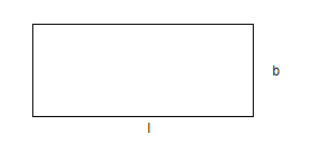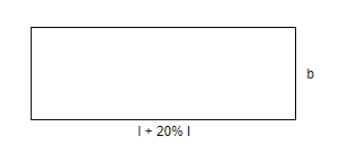Answer
434.4k+ views
Hint: The most important formulae for solving the question are as follows
The formula to find the % change in a quantity is as follows:
\[\Rightarrow \%change=\dfrac{new\ value-old\ value}{old\ value}\times 100\]
The formula to find the area of a rectangle is \[A=l\cdot b\] , where l is the length of the rectangular field and b is the breadth of the rectangular field. For such a question, we will first find the original area of the field. Then we will find the new length or new breadth of the field whichever is given and then we will find the new value of the other one which is not given to us or which is asked.
Complete step-by-step answer:
In this question, we are given that the area of a rectangle field is increased by 50% and that in this process, the length of this field is increased by 20%. Now, we are asked to find the % by which the breadth of this field is increased.

Now, we know that the area of a rectangle is given as follows:
\[A=l\cdot b\]
(Where l is the length of the rectangular field and b is the breadth of the rectangular field)
Now, as the area of this field is increased by 50%, the new area of the field that we get is as follows
\[\begin{align}
& \Rightarrow {A}'=A+50\%A \\
& \Rightarrow {A}'=A+\dfrac{50}{100}\times A \\
& \Rightarrow {A}'=A+\dfrac{1}{2}\times A \\
& \Rightarrow {A}'=\dfrac{3A}{2} \\
\end{align}\]
Now, we also know that the length of this new field is increased by 20% and the new length of the field that we get is as follows

\[\begin{align}
& \Rightarrow {l}'=l+20\%l \\
& \Rightarrow {l}'=l+\dfrac{20}{100}\times l \\
& \Rightarrow {l}'=l+\dfrac{1}{5}\times l \\
& \Rightarrow {l}'=\dfrac{6l}{5} \\
\end{align}\]
Now, for calculating the area of the new field that is given as follows
\[\Rightarrow {A}'={l}'\cdot {b}'\]
Now, putting the values of \[{A}'\ and\ {l}'\] in terms of A and l respectively, we can write as follows
\[\begin{align}
& \Rightarrow {A}'={l}'\cdot {b}' \\
& \Rightarrow \dfrac{3A}{2}=\dfrac{6l}{5}\cdot {b}' \\
\end{align}\]
Now, originally, we know that \[A=l\cdot b\] , hence, we can write the following equation using the above information as follows
\[\begin{align}
& \Rightarrow \dfrac{3l\cdot b}{2}=\dfrac{6l}{5}\cdot {b}' \\
& \Rightarrow \dfrac{b}{2}=\dfrac{2}{5}\cdot {b}' \\
& \Rightarrow \dfrac{5b}{4}={b}' \\
\end{align}\]
Now, we get that the value of the breadth ‘b’ of the field has become \[\dfrac{5b}{4}\] , so we can calculate the % change in the value of the breadth as follows
\[\begin{align}
& \Rightarrow \%change=\dfrac{new\ value-old\ value}{old\ value}\times 100 \\
& \Rightarrow \%change=\dfrac{\dfrac{5b}{4}-b}{b}\times 100 \\
& \Rightarrow \%change=\dfrac{\dfrac{b}{4}}{b}\times 100 \\
& \Rightarrow \%change=\dfrac{1}{4}\times 100 \\
& \Rightarrow \%change=25\% \\
\end{align}\]
Hence, we get that the breadth of the rectangular field increased by 25%.
Note: It is very important for the students to know the % change formula because without knowing it, one can never get to the correct answer which is given as follows
\[\Rightarrow \%change=\dfrac{new\ value-old\ value}{old\ value}\times 100\]
If they take the denominator as the new value, then the result will be different. Also, it is important for the students to remember the area of a rectangle to get to the correct answer. The students can make an error if they directly take the obtained value of the new breadth of the new rectangular field as the change that is added in the original breadth. They should know that what they have obtained is the total changed breadth of the field rather than being just the change in the original one.
The formula to find the % change in a quantity is as follows:
\[\Rightarrow \%change=\dfrac{new\ value-old\ value}{old\ value}\times 100\]
The formula to find the area of a rectangle is \[A=l\cdot b\] , where l is the length of the rectangular field and b is the breadth of the rectangular field. For such a question, we will first find the original area of the field. Then we will find the new length or new breadth of the field whichever is given and then we will find the new value of the other one which is not given to us or which is asked.
Complete step-by-step answer:
In this question, we are given that the area of a rectangle field is increased by 50% and that in this process, the length of this field is increased by 20%. Now, we are asked to find the % by which the breadth of this field is increased.

Now, we know that the area of a rectangle is given as follows:
\[A=l\cdot b\]
(Where l is the length of the rectangular field and b is the breadth of the rectangular field)
Now, as the area of this field is increased by 50%, the new area of the field that we get is as follows
\[\begin{align}
& \Rightarrow {A}'=A+50\%A \\
& \Rightarrow {A}'=A+\dfrac{50}{100}\times A \\
& \Rightarrow {A}'=A+\dfrac{1}{2}\times A \\
& \Rightarrow {A}'=\dfrac{3A}{2} \\
\end{align}\]
Now, we also know that the length of this new field is increased by 20% and the new length of the field that we get is as follows

\[\begin{align}
& \Rightarrow {l}'=l+20\%l \\
& \Rightarrow {l}'=l+\dfrac{20}{100}\times l \\
& \Rightarrow {l}'=l+\dfrac{1}{5}\times l \\
& \Rightarrow {l}'=\dfrac{6l}{5} \\
\end{align}\]
Now, for calculating the area of the new field that is given as follows
\[\Rightarrow {A}'={l}'\cdot {b}'\]
Now, putting the values of \[{A}'\ and\ {l}'\] in terms of A and l respectively, we can write as follows
\[\begin{align}
& \Rightarrow {A}'={l}'\cdot {b}' \\
& \Rightarrow \dfrac{3A}{2}=\dfrac{6l}{5}\cdot {b}' \\
\end{align}\]
Now, originally, we know that \[A=l\cdot b\] , hence, we can write the following equation using the above information as follows
\[\begin{align}
& \Rightarrow \dfrac{3l\cdot b}{2}=\dfrac{6l}{5}\cdot {b}' \\
& \Rightarrow \dfrac{b}{2}=\dfrac{2}{5}\cdot {b}' \\
& \Rightarrow \dfrac{5b}{4}={b}' \\
\end{align}\]
Now, we get that the value of the breadth ‘b’ of the field has become \[\dfrac{5b}{4}\] , so we can calculate the % change in the value of the breadth as follows
\[\begin{align}
& \Rightarrow \%change=\dfrac{new\ value-old\ value}{old\ value}\times 100 \\
& \Rightarrow \%change=\dfrac{\dfrac{5b}{4}-b}{b}\times 100 \\
& \Rightarrow \%change=\dfrac{\dfrac{b}{4}}{b}\times 100 \\
& \Rightarrow \%change=\dfrac{1}{4}\times 100 \\
& \Rightarrow \%change=25\% \\
\end{align}\]
Hence, we get that the breadth of the rectangular field increased by 25%.
Note: It is very important for the students to know the % change formula because without knowing it, one can never get to the correct answer which is given as follows
\[\Rightarrow \%change=\dfrac{new\ value-old\ value}{old\ value}\times 100\]
If they take the denominator as the new value, then the result will be different. Also, it is important for the students to remember the area of a rectangle to get to the correct answer. The students can make an error if they directly take the obtained value of the new breadth of the new rectangular field as the change that is added in the original breadth. They should know that what they have obtained is the total changed breadth of the field rather than being just the change in the original one.
Recently Updated Pages
Mark and label the given geoinformation on the outline class 11 social science CBSE

When people say No pun intended what does that mea class 8 english CBSE

Name the states which share their boundary with Indias class 9 social science CBSE

Give an account of the Northern Plains of India class 9 social science CBSE

Change the following sentences into negative and interrogative class 10 english CBSE

Advantages and disadvantages of science

Trending doubts
Which are the Top 10 Largest Countries of the World?

Difference between Prokaryotic cell and Eukaryotic class 11 biology CBSE

Fill the blanks with the suitable prepositions 1 The class 9 english CBSE

Differentiate between homogeneous and heterogeneous class 12 chemistry CBSE

How do you graph the function fx 4x class 9 maths CBSE

Select the word that is correctly spelled a Twelveth class 10 english CBSE

The Equation xxx + 2 is Satisfied when x is Equal to Class 10 Maths

Give 10 examples for herbs , shrubs , climbers , creepers

Change the following sentences into negative and interrogative class 10 english CBSE



